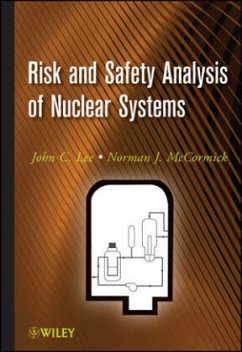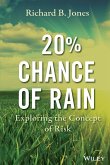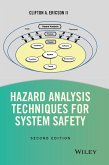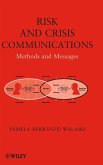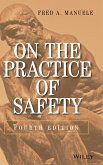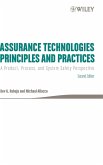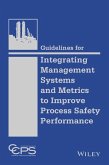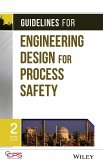- Gebundenes Buch
- Merkliste
- Auf die Merkliste
- Bewerten Bewerten
- Teilen
- Produkt teilen
- Produkterinnerung
- Produkterinnerung
The book has been developed in conjunction with NERS 462, a course offered every year to seniors and graduate students in the University of Michigan NERS program.
The first half of the book covers the principles of risk analysis, the techniques used to develop and update a reliability data base, the reliability of multi-component systems, Markov methods used to analyze the unavailability of systems with repairs, fault trees and event trees used in probabilistic risk assessments (PRAs), and failure modes of systems. All of this material is general enough that it could be used in non-nuclear…mehr
Andere Kunden interessierten sich auch für
![20% Chance of Rain 20% Chance of Rain]() Richard B. Jones20% Chance of Rain56,99 €
Richard B. Jones20% Chance of Rain56,99 €![Hazard Analysis Techniques for System Safety Hazard Analysis Techniques for System Safety]() Clifton A. EricsonHazard Analysis Techniques for System Safety137,99 €
Clifton A. EricsonHazard Analysis Techniques for System Safety137,99 €![Risk and Communication Risk and Communication]() Pamela Walaski (Ferrante)Risk and Communication94,99 €
Pamela Walaski (Ferrante)Risk and Communication94,99 €![On the Practice of Safety On the Practice of Safety]() Fred A ManueleOn the Practice of Safety124,99 €
Fred A ManueleOn the Practice of Safety124,99 €![Assurance Technologies Principles and Practices Assurance Technologies Principles and Practices]() Dev G. RahejaAssurance Technologies Principles and Practices154,99 €
Dev G. RahejaAssurance Technologies Principles and Practices154,99 €![Guidelines for Integrating Management Systems and Metrics to Improve Process Safety Performance Guidelines for Integrating Management Systems and Metrics to Improve Process Safety Performance]() Center for Chemical Process Safety (CCPS)Guidelines for Integrating Management Systems and Metrics to Improve Process Safety Performance122,99 €
Center for Chemical Process Safety (CCPS)Guidelines for Integrating Management Systems and Metrics to Improve Process Safety Performance122,99 €![Guidelines for Engineering Design for Process Safety Guidelines for Engineering Design for Process Safety]() Center for Chemical Process Safety (CCPS)Guidelines for Engineering Design for Process Safety162,99 €
Center for Chemical Process Safety (CCPS)Guidelines for Engineering Design for Process Safety162,99 €-
-
-
The book has been developed in conjunction with NERS 462, a course offered every year to seniors and graduate students in the University of Michigan NERS program.
The first half of the book covers the principles of risk analysis, the techniques used to develop and update a reliability data base, the reliability of multi-component systems, Markov methods used to analyze the unavailability of systems with repairs, fault trees and event trees used in probabilistic risk assessments (PRAs), and failure modes of systems. All of this material is general enough that it could be used in non-nuclear applications, although there is an emphasis placed on the analysis of nuclear systems.
The second half of the book covers the safety analysis of nuclear energy systems, an analysis of major accidents and incidents that occurred in commercial nuclear plants, applications of PRA techniques to the safety analysis of nuclear power plants (focusing on a major PRA study for five nuclear power plants), practical PRA examples, and emerging techniques in the structure of dynamic event trees and fault trees that can provide a more realistic representation of complex sequences of events. The book concludes with a discussion on passive safety features of advanced nuclear energy systems under development and approaches taken for risk-informed regulations for nuclear plants.
Hinweis: Dieser Artikel kann nur an eine deutsche Lieferadresse ausgeliefert werden.
The first half of the book covers the principles of risk analysis, the techniques used to develop and update a reliability data base, the reliability of multi-component systems, Markov methods used to analyze the unavailability of systems with repairs, fault trees and event trees used in probabilistic risk assessments (PRAs), and failure modes of systems. All of this material is general enough that it could be used in non-nuclear applications, although there is an emphasis placed on the analysis of nuclear systems.
The second half of the book covers the safety analysis of nuclear energy systems, an analysis of major accidents and incidents that occurred in commercial nuclear plants, applications of PRA techniques to the safety analysis of nuclear power plants (focusing on a major PRA study for five nuclear power plants), practical PRA examples, and emerging techniques in the structure of dynamic event trees and fault trees that can provide a more realistic representation of complex sequences of events. The book concludes with a discussion on passive safety features of advanced nuclear energy systems under development and approaches taken for risk-informed regulations for nuclear plants.
Hinweis: Dieser Artikel kann nur an eine deutsche Lieferadresse ausgeliefert werden.
Produktdetails
- Produktdetails
- Verlag: Wiley & Sons
- 1. Auflage
- Seitenzahl: 504
- Erscheinungstermin: 5. Juli 2011
- Englisch
- Abmessung: 236mm x 163mm x 30mm
- Gewicht: 803g
- ISBN-13: 9780470907566
- ISBN-10: 0470907568
- Artikelnr.: 32460344
- Herstellerkennzeichnung
- Libri GmbH
- Europaallee 1
- 36244 Bad Hersfeld
- gpsr@libri.de
- Verlag: Wiley & Sons
- 1. Auflage
- Seitenzahl: 504
- Erscheinungstermin: 5. Juli 2011
- Englisch
- Abmessung: 236mm x 163mm x 30mm
- Gewicht: 803g
- ISBN-13: 9780470907566
- ISBN-10: 0470907568
- Artikelnr.: 32460344
- Herstellerkennzeichnung
- Libri GmbH
- Europaallee 1
- 36244 Bad Hersfeld
- gpsr@libri.de
JOHN C. LEE, PhD, has been Professor of Nuclear Engineering at the University of Michigan since 1974, following five years of employment at Westinghouse Electric Corporation and General Electric Company. He has written for approximately 180 publications on broad areas of nuclear reactor physics and engineering, including nuclear systems analysis and diagnostics. Dr. Lee is a Fellow of the American Nuclear Society. NORMAN J. McCORMICK, PhD, is an emeritus professor of mechanical engineering at the University of Washington who retired in 2003. From 1966 until the early 1990s, he was a professor of nuclear engineering. Dr. McCormick is the author of the book Reliability and Risk Analysis Methods and Nuclear Power Applications (upon which part of NERS 462 is based) and has authored approximately 150 journal articles. He is a Fellow of the American Nuclear Society.
Preface xii
Permissions and Copyrights xiv
List of Tables xvi
List of Figures xviii
1 Risk and Safety of Engineered Systems 1
1.1 Risk and Its Perception and Acceptance 1
1.2 Overview of Risk and Safety Analysis 6
1.3 Two Historical Reactor Accidents 8
1.4 Definition of Risk 9
1.5 Reliability, Availability, Maintainability, and Safety 10
1.6 Organization of the Book 12
References 13
2 Probabilities of Events 15
2.1 Events 15
2.2 Event Tree Analysis and Minimal Cut Sets 17
2.3 Probabilities 19
2.3.1 Interpretations of Probability 19
2.3.2 Axiomatic Approach to Probabilities 20
2.3.3 Intersection of Events 21
2.3.4 Union of Events 22
2.3.5 Decomposition Rule for Probabilities 25
2.4 TimeIndependent Versus TimeDependent Probabilities 25
2.5 TimeIndependent Probabilities 26
2.5.1 Introduction 26
2.5.2 TimeIndependent Probability Distributions 27
2.6 Normal Distribution 31
2.7 Reliability Functions 35
2.8 TimeDependent Probability Distributions 41
2.8.1 Erlangian and Exponential Distributions 42
2.8.2 Gamma Distribution 43
2.8.3 Lognormal Distribution 44
2.8.4 Weibull Distribution 46
2.8.5 Generalized "Bathtub" Distribution 47
2.8.6 Selection of a TimeDependent Probability Distribution 48
2.9 ExtremeValue Probability Distributions 50
2.10 Probability Models for Failure Analyses 52
References 53
Exercises 53
3 Reliability Data 59
3.1 Estimation Theory 59
3.1.1 Moment Estimators 60
3.1.2 Maximum Likelihood Estimators 61
3.1.3 Maximum Entropy Estimators 64
3.1.4 Comparison of Estimators 65
3.2 Bayesian Updating of Data 65
3.2.1 Bayes Equation 65
3.2.2 Applications of the Bayes Equation 67
3.3 Central Limit Theorem and Hypothesis Testing 70
3.3.1 Interpretation of the Central Limit Theorem 71
3.3.2 Hypothesis Testing with the Central Limit Theorem 72
3.4 Reliability Quantification 74
3.4.1 Central Limit Theorem for Reliability Quantification 74
3.4.2 Engineering Approach for Reliability Quantification 76
3.4.3 2Distribution for Reliability Quantification 77
3.4.4 ThreeWay Comparison and Concluding Remarks 78
References 80
Exercises 80
4 Reliability of MultipleComponent Systems 85
4.1 Series and ActiveParallel Systems 86
4.1.1 Systems with Independent Components 86
4.1.2 Systems with Redundant Components 88
4.1.3 FailtoSafety and FailtoDanger Systems 90
4.2 Systems with Standby Components 93
4.3 Decomposition Analysis 96
4.4 Signal Flow Graph Analysis 100
4.5 Cut Set Analysis 101
References 104
Exercises 104
5 Availability and Reliability of Systems with Repair 109
5.1 Introduction 109
5.2 Markov Method 111
5.2.1 Markov Governing Equations 111
5.2.2 Solution of Markov Governing Equations 113
5.2.3 An Elementary Example 116
5.3 Availability Analyses 118
5.3.1 Rules for Constructing Transition Rate Matrices 118
5.3.2 Availability Transition Rate Matrices 119
5.3.3 TimeDependent Availability Examples 123
5.3.4 SteadyState Availability 127
5.4 Reliability Analyses 128
5.4.1 Reliability Transition Rate Matrices 129
5.4.2 TimeDependent Reliability Examples 130
5.4.3 Mean Time to Failure 130
5.5 Additional Capabilities of Markov Models 133
5.5.1 Imperfect Switching Between System States 134
5.5.2 Systems with Nonconstant Hazard Rates 136
References 137
Exercises 137
6 Probabilistic Risk Assessment 141
6.1 Failure Modes 142
6.2 Classification of Failure Events 143
6.2.1 Primary, Secondary, and Command Failures 143
6.2.2 Common Cause Failures 144
6.2.3 Human Errors 148
6.3 Failure Data 150
6.3.1 Hardware Failures 150
6.3.2 Human Errors 150
6.4 Combination of Failures and Consequences 152
6.4.1 Inductive Methods 152
6.4.2 Event Tree Analysis 154
6.5 Fault Tree Analysis 156
6.5.1 Introduction 156
6.5.2 Fault Tree Construction 157
6.5.3 Qualitative Fault Tree Analysis 157
6.5.4 Quantitative Fault Tree Analysis 160
6.5.5 Common Cause Failures and Fault Tree Analysis 165
6.6 Master Logic Diagram 165
6.7 Uncertainty and Importance Analysis 168
6.7.1 Types of Uncertainty in PRAs 168
6.7.2 Stochastic Uncertainty Analysis 169
6.7.3 Sensitivity and Importance Analysis 170
References 172
Exercises 172
7 Computer Programs for Probabilistic Risk Assessment 179
7.1 Fault Tree Methodology of the SAPHIRE Code 179
7.1.1 Gate Conversion and Tree Restructuring 180
7.1.2 Simplification of the Tree 180
7.1.3 Fault Tree Expansion and Reduction 182
7.2 Fault and Event Tree Evaluation with the SAPHIRE Code 183
7.3 Other Features of the SAPHIRE Code 185
7.4 Other PRA Codes 185
7.5 Binary Decision Diagram Algorithm 187
7.5.1 Basic Formulation of the BDD Algorithm 187
7.5.2 Generalization of the BDD Formulation 189
7.5.3 Zero Suppressed BDD Algorithm and the FTREX Code 193
References 194
Exercises 195
8 Nuclear Power Plant Safety Analysis 197
8.1 Engineered Safety Features of Nuclear Power Plants 197
8.1.1 Pressurized Water Reactor 198
8.1.2 Boiling Water Reactor 210
8.2 Accident Classification and General Design Goals 215
8.2.1 Plant Operating States 217
8.2.2 Accident Classification in 10 CFR 50 217
8.2.3 General Design Criteria and Safety Goals 219
8.3 Design Basis Accident: LargeBreak LOCA 220
8.3.1 Typical Sequence of a ColdLeg LBLOCA in PWR 221
8.3.2 ECCS Specifications 225
8.3.3 Code Scaling, Applicability, and Uncertainty Evaluation 227
8.4 Severe (Class 9) Accidents 231
8.5 Anticipated Transients Without Scram 233
8.5.1 History and Background of the ATWS Issue 233
8.5.2 Resolution of the ATWS Issues 235
8.5.3 Power Coefficients of Reactivity in LWRs 237
8.6 Radiological Source and Atmospheric Dispersion 241
8.6.1 Radiological Source Term 242
8.6.2 Atmospheric Dispersion of Radioactive Plume 243
8.6.3 Simple Models for Dose Rate Calculation 247
8.7 Biological Effects of Radiation Exposure 250
References 252
Exercises 254
9 Major Nuclear Power Plant Accidents and Incidents 259
9.1 Three Mile Island Unit 2 Accident 260
9.1.1 Sequence of the Accident-March 1979 260
9.1.2 Implications and FollowUp of the Accident 260
9.2 PWR InVessel Accident Progression 263
9.2.1 Core Uncovery and Heatup 265
9.2.2 Cladding Oxidation 266
9.2.3 Clad Melting and Fuel Liquefaction 268
9.2.4 Molten Core Slumping and Relocation 270
9.2.5 Vessel Breach 271
9.3 Chernobyl Accident 272
9.3.1 Cause and Nature of the Accident-April 1986 272
9.3.2 Sequence of the Accident 274
9.3.3 Estimate of Energy Release in the Accident 275
9.3.4 Accident Consequences 275
9.3.5 Comparison of the TMI and Chernobyl Accidents 276
9.4 Fukushima Station Accident 277
9.4.1 Overview of the Accident-March 2011 277
9.4.2 Radiological Consequences of the Accident 278
9.4.3 Implications and FollowUp of the Fukushima Accident 279
9.5 Salem Anticipated Transient Without Scram 281
9.5.1 Chronology and Cause of the Salem Incident 281
9.5.2 Implications and FollowUp of the Salem ATWS Event 282
9.6 LaSalle Transient Event 284
9.6.1 LaSalle NuclearCoupled DensityWave Oscillations 284
9.6.2 Simple Model for NuclearCoupled DensityWave Oscillations 287
9.6.3 Implications and FollowUp of the LaSalle Incident 292
9.7 DavisBesse Potential LOCA Event 292
9.7.1 Background and Chronology of the Incident 292
9.7.2 NRC Decision to Grant DB Shutdown Delay 293
9.7.3 Causes for the DavisBesse Incident and FollowUp 298
References 298
Exercises 301
10 PRA Studies of Nuclear Power Plants 303
10.1 WASH1400
Reactor Safety Study 304
10.2 Assessment of Severe Accident Risks: NUREG1150. 311
10.2.1 Background and Scope of the NUREG1150 Study 311
10.2.2 Overview of NUREG1150 Methodology 313
10.2.3 Accident Frequency Analysis 315
10.2.4 Accident Progression Analysis 320
10.2.5 Radionuclide Transport Analysis 324
10.2.6 Offsite Consequence Analysis 327
10.2.7 Uncertainty Analysis 330
10.2.8 Risk Integration 331
10.2.9 Additional Perspectives and Comments on NUREG1150. 337
10.3 Simplified PRA in the Structure of NUREG1150. 340
10.3.1 Description of the Simplified PRA Model 340
10.3.2 Parametric Studies and Comments on the Simplified PRA Model 344
References 345
Exercises 347
11 Passive Safety and Advanced Nuclear Energy Systems 349
11.1 Passive Safety Demonstration Tests at EBRII 349
11.1.1 EBRII Primary System and Simplified Model 350
11.1.2 Unprotected LossofFlow and LossofHeatSink Tests 357
11.1.3 Simplified Fuel Channel Analysis 361
11.1.4 Implications of EBRII Passive Safety Demonstration Tests 362
11.2 Safety Characteristics of Generation III+ Plants 364
11.2.1 AP1000 Design Features 364
11.2.2 SmallBreak LOCA Analysis for AP1000 366
11.2.3 Economic Simplified Boiling Water Reactor 371
11.2.4 Reliability Quantification of SBWR Passive Safety Containment 375
11.3 Generation IV Nuclear Power Plants 382
11.3.1 SodiumCooled Fast Reactor 383
11.3.2 Hypothetical Core Disruptive Accidents for Fast Reactors 387
11.3.3 VHTR and Phenomena Identification and Ranking Table 393
References 396
Exercises 399
12 RiskInformed Regulations and ReliabilityCentered Maintenance 401
12.1 Risk Measures for Nuclear Plant Regulations 402
12.1.1 Principles of RiskInformed Regulations and Licensing 402
12.1.2 Uncertainties in RiskInformed Decision Making 405
12.1.3 Other Initiatives in RiskInformed Regulations 406
12.2 ReliabilityCentered Maintenance 406
12.2.1 Optimization Strategy for Preventive Maintenance 407
12.2.2 ReliabilityCentered Maintenance Framework 409
12.2.3 CostBenefit Considerations 410
References 413
Exercises 415
13 Dynamic Event Tree Analysis 417
13.1 Basic Features of Dynamic Event Tree Analysis 418
13.2 Continuous Event Tree Formulation 421
13.2.1 Derivation of the Stochastic Balance Equation 421
13.2.2 Integral Form of the Stochastic Balance Equation 423
13.2.3 Numerical Solution of the Stochastic Balance Equation 425
13.3 CelltoCell Mapping for Parameter Estimation 426
13.3.1 Derivation of the Bayesian Recursive Relationship 427
13.3.2 CCM Technique for Dynamic Event Tree Construction 430
13.4 Diagnosis of Component Degradations 434
13.4.1 Bayesian Framework for Component Diagnostics 434
13.4.2 Implementation of the Probabilistic Diagnostic Algorithm 437
References 441
Exercises 442
Appendix A: Reactor Radiological Sources 443
A.1 Fission Product Inventory and Decay Heat 443
A.2 Health Effects of Radiation Exposure 446
References 448
Appendix B: Some Special Mathematical Functions 449
B.1 Gamma Function 449
B.2 Error Function 451
References 451
Appendix C: Some Failure Rate Data 453
Appendix D: Linear Kalman Filter Algorithm 457
References 461
Answers to Selected Exercises 462
Index and Acronyms 467
Permissions and Copyrights xiv
List of Tables xvi
List of Figures xviii
1 Risk and Safety of Engineered Systems 1
1.1 Risk and Its Perception and Acceptance 1
1.2 Overview of Risk and Safety Analysis 6
1.3 Two Historical Reactor Accidents 8
1.4 Definition of Risk 9
1.5 Reliability, Availability, Maintainability, and Safety 10
1.6 Organization of the Book 12
References 13
2 Probabilities of Events 15
2.1 Events 15
2.2 Event Tree Analysis and Minimal Cut Sets 17
2.3 Probabilities 19
2.3.1 Interpretations of Probability 19
2.3.2 Axiomatic Approach to Probabilities 20
2.3.3 Intersection of Events 21
2.3.4 Union of Events 22
2.3.5 Decomposition Rule for Probabilities 25
2.4 TimeIndependent Versus TimeDependent Probabilities 25
2.5 TimeIndependent Probabilities 26
2.5.1 Introduction 26
2.5.2 TimeIndependent Probability Distributions 27
2.6 Normal Distribution 31
2.7 Reliability Functions 35
2.8 TimeDependent Probability Distributions 41
2.8.1 Erlangian and Exponential Distributions 42
2.8.2 Gamma Distribution 43
2.8.3 Lognormal Distribution 44
2.8.4 Weibull Distribution 46
2.8.5 Generalized "Bathtub" Distribution 47
2.8.6 Selection of a TimeDependent Probability Distribution 48
2.9 ExtremeValue Probability Distributions 50
2.10 Probability Models for Failure Analyses 52
References 53
Exercises 53
3 Reliability Data 59
3.1 Estimation Theory 59
3.1.1 Moment Estimators 60
3.1.2 Maximum Likelihood Estimators 61
3.1.3 Maximum Entropy Estimators 64
3.1.4 Comparison of Estimators 65
3.2 Bayesian Updating of Data 65
3.2.1 Bayes Equation 65
3.2.2 Applications of the Bayes Equation 67
3.3 Central Limit Theorem and Hypothesis Testing 70
3.3.1 Interpretation of the Central Limit Theorem 71
3.3.2 Hypothesis Testing with the Central Limit Theorem 72
3.4 Reliability Quantification 74
3.4.1 Central Limit Theorem for Reliability Quantification 74
3.4.2 Engineering Approach for Reliability Quantification 76
3.4.3 2Distribution for Reliability Quantification 77
3.4.4 ThreeWay Comparison and Concluding Remarks 78
References 80
Exercises 80
4 Reliability of MultipleComponent Systems 85
4.1 Series and ActiveParallel Systems 86
4.1.1 Systems with Independent Components 86
4.1.2 Systems with Redundant Components 88
4.1.3 FailtoSafety and FailtoDanger Systems 90
4.2 Systems with Standby Components 93
4.3 Decomposition Analysis 96
4.4 Signal Flow Graph Analysis 100
4.5 Cut Set Analysis 101
References 104
Exercises 104
5 Availability and Reliability of Systems with Repair 109
5.1 Introduction 109
5.2 Markov Method 111
5.2.1 Markov Governing Equations 111
5.2.2 Solution of Markov Governing Equations 113
5.2.3 An Elementary Example 116
5.3 Availability Analyses 118
5.3.1 Rules for Constructing Transition Rate Matrices 118
5.3.2 Availability Transition Rate Matrices 119
5.3.3 TimeDependent Availability Examples 123
5.3.4 SteadyState Availability 127
5.4 Reliability Analyses 128
5.4.1 Reliability Transition Rate Matrices 129
5.4.2 TimeDependent Reliability Examples 130
5.4.3 Mean Time to Failure 130
5.5 Additional Capabilities of Markov Models 133
5.5.1 Imperfect Switching Between System States 134
5.5.2 Systems with Nonconstant Hazard Rates 136
References 137
Exercises 137
6 Probabilistic Risk Assessment 141
6.1 Failure Modes 142
6.2 Classification of Failure Events 143
6.2.1 Primary, Secondary, and Command Failures 143
6.2.2 Common Cause Failures 144
6.2.3 Human Errors 148
6.3 Failure Data 150
6.3.1 Hardware Failures 150
6.3.2 Human Errors 150
6.4 Combination of Failures and Consequences 152
6.4.1 Inductive Methods 152
6.4.2 Event Tree Analysis 154
6.5 Fault Tree Analysis 156
6.5.1 Introduction 156
6.5.2 Fault Tree Construction 157
6.5.3 Qualitative Fault Tree Analysis 157
6.5.4 Quantitative Fault Tree Analysis 160
6.5.5 Common Cause Failures and Fault Tree Analysis 165
6.6 Master Logic Diagram 165
6.7 Uncertainty and Importance Analysis 168
6.7.1 Types of Uncertainty in PRAs 168
6.7.2 Stochastic Uncertainty Analysis 169
6.7.3 Sensitivity and Importance Analysis 170
References 172
Exercises 172
7 Computer Programs for Probabilistic Risk Assessment 179
7.1 Fault Tree Methodology of the SAPHIRE Code 179
7.1.1 Gate Conversion and Tree Restructuring 180
7.1.2 Simplification of the Tree 180
7.1.3 Fault Tree Expansion and Reduction 182
7.2 Fault and Event Tree Evaluation with the SAPHIRE Code 183
7.3 Other Features of the SAPHIRE Code 185
7.4 Other PRA Codes 185
7.5 Binary Decision Diagram Algorithm 187
7.5.1 Basic Formulation of the BDD Algorithm 187
7.5.2 Generalization of the BDD Formulation 189
7.5.3 Zero Suppressed BDD Algorithm and the FTREX Code 193
References 194
Exercises 195
8 Nuclear Power Plant Safety Analysis 197
8.1 Engineered Safety Features of Nuclear Power Plants 197
8.1.1 Pressurized Water Reactor 198
8.1.2 Boiling Water Reactor 210
8.2 Accident Classification and General Design Goals 215
8.2.1 Plant Operating States 217
8.2.2 Accident Classification in 10 CFR 50 217
8.2.3 General Design Criteria and Safety Goals 219
8.3 Design Basis Accident: LargeBreak LOCA 220
8.3.1 Typical Sequence of a ColdLeg LBLOCA in PWR 221
8.3.2 ECCS Specifications 225
8.3.3 Code Scaling, Applicability, and Uncertainty Evaluation 227
8.4 Severe (Class 9) Accidents 231
8.5 Anticipated Transients Without Scram 233
8.5.1 History and Background of the ATWS Issue 233
8.5.2 Resolution of the ATWS Issues 235
8.5.3 Power Coefficients of Reactivity in LWRs 237
8.6 Radiological Source and Atmospheric Dispersion 241
8.6.1 Radiological Source Term 242
8.6.2 Atmospheric Dispersion of Radioactive Plume 243
8.6.3 Simple Models for Dose Rate Calculation 247
8.7 Biological Effects of Radiation Exposure 250
References 252
Exercises 254
9 Major Nuclear Power Plant Accidents and Incidents 259
9.1 Three Mile Island Unit 2 Accident 260
9.1.1 Sequence of the Accident-March 1979 260
9.1.2 Implications and FollowUp of the Accident 260
9.2 PWR InVessel Accident Progression 263
9.2.1 Core Uncovery and Heatup 265
9.2.2 Cladding Oxidation 266
9.2.3 Clad Melting and Fuel Liquefaction 268
9.2.4 Molten Core Slumping and Relocation 270
9.2.5 Vessel Breach 271
9.3 Chernobyl Accident 272
9.3.1 Cause and Nature of the Accident-April 1986 272
9.3.2 Sequence of the Accident 274
9.3.3 Estimate of Energy Release in the Accident 275
9.3.4 Accident Consequences 275
9.3.5 Comparison of the TMI and Chernobyl Accidents 276
9.4 Fukushima Station Accident 277
9.4.1 Overview of the Accident-March 2011 277
9.4.2 Radiological Consequences of the Accident 278
9.4.3 Implications and FollowUp of the Fukushima Accident 279
9.5 Salem Anticipated Transient Without Scram 281
9.5.1 Chronology and Cause of the Salem Incident 281
9.5.2 Implications and FollowUp of the Salem ATWS Event 282
9.6 LaSalle Transient Event 284
9.6.1 LaSalle NuclearCoupled DensityWave Oscillations 284
9.6.2 Simple Model for NuclearCoupled DensityWave Oscillations 287
9.6.3 Implications and FollowUp of the LaSalle Incident 292
9.7 DavisBesse Potential LOCA Event 292
9.7.1 Background and Chronology of the Incident 292
9.7.2 NRC Decision to Grant DB Shutdown Delay 293
9.7.3 Causes for the DavisBesse Incident and FollowUp 298
References 298
Exercises 301
10 PRA Studies of Nuclear Power Plants 303
10.1 WASH1400
Reactor Safety Study 304
10.2 Assessment of Severe Accident Risks: NUREG1150. 311
10.2.1 Background and Scope of the NUREG1150 Study 311
10.2.2 Overview of NUREG1150 Methodology 313
10.2.3 Accident Frequency Analysis 315
10.2.4 Accident Progression Analysis 320
10.2.5 Radionuclide Transport Analysis 324
10.2.6 Offsite Consequence Analysis 327
10.2.7 Uncertainty Analysis 330
10.2.8 Risk Integration 331
10.2.9 Additional Perspectives and Comments on NUREG1150. 337
10.3 Simplified PRA in the Structure of NUREG1150. 340
10.3.1 Description of the Simplified PRA Model 340
10.3.2 Parametric Studies and Comments on the Simplified PRA Model 344
References 345
Exercises 347
11 Passive Safety and Advanced Nuclear Energy Systems 349
11.1 Passive Safety Demonstration Tests at EBRII 349
11.1.1 EBRII Primary System and Simplified Model 350
11.1.2 Unprotected LossofFlow and LossofHeatSink Tests 357
11.1.3 Simplified Fuel Channel Analysis 361
11.1.4 Implications of EBRII Passive Safety Demonstration Tests 362
11.2 Safety Characteristics of Generation III+ Plants 364
11.2.1 AP1000 Design Features 364
11.2.2 SmallBreak LOCA Analysis for AP1000 366
11.2.3 Economic Simplified Boiling Water Reactor 371
11.2.4 Reliability Quantification of SBWR Passive Safety Containment 375
11.3 Generation IV Nuclear Power Plants 382
11.3.1 SodiumCooled Fast Reactor 383
11.3.2 Hypothetical Core Disruptive Accidents for Fast Reactors 387
11.3.3 VHTR and Phenomena Identification and Ranking Table 393
References 396
Exercises 399
12 RiskInformed Regulations and ReliabilityCentered Maintenance 401
12.1 Risk Measures for Nuclear Plant Regulations 402
12.1.1 Principles of RiskInformed Regulations and Licensing 402
12.1.2 Uncertainties in RiskInformed Decision Making 405
12.1.3 Other Initiatives in RiskInformed Regulations 406
12.2 ReliabilityCentered Maintenance 406
12.2.1 Optimization Strategy for Preventive Maintenance 407
12.2.2 ReliabilityCentered Maintenance Framework 409
12.2.3 CostBenefit Considerations 410
References 413
Exercises 415
13 Dynamic Event Tree Analysis 417
13.1 Basic Features of Dynamic Event Tree Analysis 418
13.2 Continuous Event Tree Formulation 421
13.2.1 Derivation of the Stochastic Balance Equation 421
13.2.2 Integral Form of the Stochastic Balance Equation 423
13.2.3 Numerical Solution of the Stochastic Balance Equation 425
13.3 CelltoCell Mapping for Parameter Estimation 426
13.3.1 Derivation of the Bayesian Recursive Relationship 427
13.3.2 CCM Technique for Dynamic Event Tree Construction 430
13.4 Diagnosis of Component Degradations 434
13.4.1 Bayesian Framework for Component Diagnostics 434
13.4.2 Implementation of the Probabilistic Diagnostic Algorithm 437
References 441
Exercises 442
Appendix A: Reactor Radiological Sources 443
A.1 Fission Product Inventory and Decay Heat 443
A.2 Health Effects of Radiation Exposure 446
References 448
Appendix B: Some Special Mathematical Functions 449
B.1 Gamma Function 449
B.2 Error Function 451
References 451
Appendix C: Some Failure Rate Data 453
Appendix D: Linear Kalman Filter Algorithm 457
References 461
Answers to Selected Exercises 462
Index and Acronyms 467
Preface xii
Permissions and Copyrights xiv
List of Tables xvi
List of Figures xviii
1 Risk and Safety of Engineered Systems 1
1.1 Risk and Its Perception and Acceptance 1
1.2 Overview of Risk and Safety Analysis 6
1.3 Two Historical Reactor Accidents 8
1.4 Definition of Risk 9
1.5 Reliability, Availability, Maintainability, and Safety 10
1.6 Organization of the Book 12
References 13
2 Probabilities of Events 15
2.1 Events 15
2.2 Event Tree Analysis and Minimal Cut Sets 17
2.3 Probabilities 19
2.3.1 Interpretations of Probability 19
2.3.2 Axiomatic Approach to Probabilities 20
2.3.3 Intersection of Events 21
2.3.4 Union of Events 22
2.3.5 Decomposition Rule for Probabilities 25
2.4 TimeIndependent Versus TimeDependent Probabilities 25
2.5 TimeIndependent Probabilities 26
2.5.1 Introduction 26
2.5.2 TimeIndependent Probability Distributions 27
2.6 Normal Distribution 31
2.7 Reliability Functions 35
2.8 TimeDependent Probability Distributions 41
2.8.1 Erlangian and Exponential Distributions 42
2.8.2 Gamma Distribution 43
2.8.3 Lognormal Distribution 44
2.8.4 Weibull Distribution 46
2.8.5 Generalized "Bathtub" Distribution 47
2.8.6 Selection of a TimeDependent Probability Distribution 48
2.9 ExtremeValue Probability Distributions 50
2.10 Probability Models for Failure Analyses 52
References 53
Exercises 53
3 Reliability Data 59
3.1 Estimation Theory 59
3.1.1 Moment Estimators 60
3.1.2 Maximum Likelihood Estimators 61
3.1.3 Maximum Entropy Estimators 64
3.1.4 Comparison of Estimators 65
3.2 Bayesian Updating of Data 65
3.2.1 Bayes Equation 65
3.2.2 Applications of the Bayes Equation 67
3.3 Central Limit Theorem and Hypothesis Testing 70
3.3.1 Interpretation of the Central Limit Theorem 71
3.3.2 Hypothesis Testing with the Central Limit Theorem 72
3.4 Reliability Quantification 74
3.4.1 Central Limit Theorem for Reliability Quantification 74
3.4.2 Engineering Approach for Reliability Quantification 76
3.4.3 2Distribution for Reliability Quantification 77
3.4.4 ThreeWay Comparison and Concluding Remarks 78
References 80
Exercises 80
4 Reliability of MultipleComponent Systems 85
4.1 Series and ActiveParallel Systems 86
4.1.1 Systems with Independent Components 86
4.1.2 Systems with Redundant Components 88
4.1.3 FailtoSafety and FailtoDanger Systems 90
4.2 Systems with Standby Components 93
4.3 Decomposition Analysis 96
4.4 Signal Flow Graph Analysis 100
4.5 Cut Set Analysis 101
References 104
Exercises 104
5 Availability and Reliability of Systems with Repair 109
5.1 Introduction 109
5.2 Markov Method 111
5.2.1 Markov Governing Equations 111
5.2.2 Solution of Markov Governing Equations 113
5.2.3 An Elementary Example 116
5.3 Availability Analyses 118
5.3.1 Rules for Constructing Transition Rate Matrices 118
5.3.2 Availability Transition Rate Matrices 119
5.3.3 TimeDependent Availability Examples 123
5.3.4 SteadyState Availability 127
5.4 Reliability Analyses 128
5.4.1 Reliability Transition Rate Matrices 129
5.4.2 TimeDependent Reliability Examples 130
5.4.3 Mean Time to Failure 130
5.5 Additional Capabilities of Markov Models 133
5.5.1 Imperfect Switching Between System States 134
5.5.2 Systems with Nonconstant Hazard Rates 136
References 137
Exercises 137
6 Probabilistic Risk Assessment 141
6.1 Failure Modes 142
6.2 Classification of Failure Events 143
6.2.1 Primary, Secondary, and Command Failures 143
6.2.2 Common Cause Failures 144
6.2.3 Human Errors 148
6.3 Failure Data 150
6.3.1 Hardware Failures 150
6.3.2 Human Errors 150
6.4 Combination of Failures and Consequences 152
6.4.1 Inductive Methods 152
6.4.2 Event Tree Analysis 154
6.5 Fault Tree Analysis 156
6.5.1 Introduction 156
6.5.2 Fault Tree Construction 157
6.5.3 Qualitative Fault Tree Analysis 157
6.5.4 Quantitative Fault Tree Analysis 160
6.5.5 Common Cause Failures and Fault Tree Analysis 165
6.6 Master Logic Diagram 165
6.7 Uncertainty and Importance Analysis 168
6.7.1 Types of Uncertainty in PRAs 168
6.7.2 Stochastic Uncertainty Analysis 169
6.7.3 Sensitivity and Importance Analysis 170
References 172
Exercises 172
7 Computer Programs for Probabilistic Risk Assessment 179
7.1 Fault Tree Methodology of the SAPHIRE Code 179
7.1.1 Gate Conversion and Tree Restructuring 180
7.1.2 Simplification of the Tree 180
7.1.3 Fault Tree Expansion and Reduction 182
7.2 Fault and Event Tree Evaluation with the SAPHIRE Code 183
7.3 Other Features of the SAPHIRE Code 185
7.4 Other PRA Codes 185
7.5 Binary Decision Diagram Algorithm 187
7.5.1 Basic Formulation of the BDD Algorithm 187
7.5.2 Generalization of the BDD Formulation 189
7.5.3 Zero Suppressed BDD Algorithm and the FTREX Code 193
References 194
Exercises 195
8 Nuclear Power Plant Safety Analysis 197
8.1 Engineered Safety Features of Nuclear Power Plants 197
8.1.1 Pressurized Water Reactor 198
8.1.2 Boiling Water Reactor 210
8.2 Accident Classification and General Design Goals 215
8.2.1 Plant Operating States 217
8.2.2 Accident Classification in 10 CFR 50 217
8.2.3 General Design Criteria and Safety Goals 219
8.3 Design Basis Accident: LargeBreak LOCA 220
8.3.1 Typical Sequence of a ColdLeg LBLOCA in PWR 221
8.3.2 ECCS Specifications 225
8.3.3 Code Scaling, Applicability, and Uncertainty Evaluation 227
8.4 Severe (Class 9) Accidents 231
8.5 Anticipated Transients Without Scram 233
8.5.1 History and Background of the ATWS Issue 233
8.5.2 Resolution of the ATWS Issues 235
8.5.3 Power Coefficients of Reactivity in LWRs 237
8.6 Radiological Source and Atmospheric Dispersion 241
8.6.1 Radiological Source Term 242
8.6.2 Atmospheric Dispersion of Radioactive Plume 243
8.6.3 Simple Models for Dose Rate Calculation 247
8.7 Biological Effects of Radiation Exposure 250
References 252
Exercises 254
9 Major Nuclear Power Plant Accidents and Incidents 259
9.1 Three Mile Island Unit 2 Accident 260
9.1.1 Sequence of the Accident-March 1979 260
9.1.2 Implications and FollowUp of the Accident 260
9.2 PWR InVessel Accident Progression 263
9.2.1 Core Uncovery and Heatup 265
9.2.2 Cladding Oxidation 266
9.2.3 Clad Melting and Fuel Liquefaction 268
9.2.4 Molten Core Slumping and Relocation 270
9.2.5 Vessel Breach 271
9.3 Chernobyl Accident 272
9.3.1 Cause and Nature of the Accident-April 1986 272
9.3.2 Sequence of the Accident 274
9.3.3 Estimate of Energy Release in the Accident 275
9.3.4 Accident Consequences 275
9.3.5 Comparison of the TMI and Chernobyl Accidents 276
9.4 Fukushima Station Accident 277
9.4.1 Overview of the Accident-March 2011 277
9.4.2 Radiological Consequences of the Accident 278
9.4.3 Implications and FollowUp of the Fukushima Accident 279
9.5 Salem Anticipated Transient Without Scram 281
9.5.1 Chronology and Cause of the Salem Incident 281
9.5.2 Implications and FollowUp of the Salem ATWS Event 282
9.6 LaSalle Transient Event 284
9.6.1 LaSalle NuclearCoupled DensityWave Oscillations 284
9.6.2 Simple Model for NuclearCoupled DensityWave Oscillations 287
9.6.3 Implications and FollowUp of the LaSalle Incident 292
9.7 DavisBesse Potential LOCA Event 292
9.7.1 Background and Chronology of the Incident 292
9.7.2 NRC Decision to Grant DB Shutdown Delay 293
9.7.3 Causes for the DavisBesse Incident and FollowUp 298
References 298
Exercises 301
10 PRA Studies of Nuclear Power Plants 303
10.1 WASH1400
Reactor Safety Study 304
10.2 Assessment of Severe Accident Risks: NUREG1150. 311
10.2.1 Background and Scope of the NUREG1150 Study 311
10.2.2 Overview of NUREG1150 Methodology 313
10.2.3 Accident Frequency Analysis 315
10.2.4 Accident Progression Analysis 320
10.2.5 Radionuclide Transport Analysis 324
10.2.6 Offsite Consequence Analysis 327
10.2.7 Uncertainty Analysis 330
10.2.8 Risk Integration 331
10.2.9 Additional Perspectives and Comments on NUREG1150. 337
10.3 Simplified PRA in the Structure of NUREG1150. 340
10.3.1 Description of the Simplified PRA Model 340
10.3.2 Parametric Studies and Comments on the Simplified PRA Model 344
References 345
Exercises 347
11 Passive Safety and Advanced Nuclear Energy Systems 349
11.1 Passive Safety Demonstration Tests at EBRII 349
11.1.1 EBRII Primary System and Simplified Model 350
11.1.2 Unprotected LossofFlow and LossofHeatSink Tests 357
11.1.3 Simplified Fuel Channel Analysis 361
11.1.4 Implications of EBRII Passive Safety Demonstration Tests 362
11.2 Safety Characteristics of Generation III+ Plants 364
11.2.1 AP1000 Design Features 364
11.2.2 SmallBreak LOCA Analysis for AP1000 366
11.2.3 Economic Simplified Boiling Water Reactor 371
11.2.4 Reliability Quantification of SBWR Passive Safety Containment 375
11.3 Generation IV Nuclear Power Plants 382
11.3.1 SodiumCooled Fast Reactor 383
11.3.2 Hypothetical Core Disruptive Accidents for Fast Reactors 387
11.3.3 VHTR and Phenomena Identification and Ranking Table 393
References 396
Exercises 399
12 RiskInformed Regulations and ReliabilityCentered Maintenance 401
12.1 Risk Measures for Nuclear Plant Regulations 402
12.1.1 Principles of RiskInformed Regulations and Licensing 402
12.1.2 Uncertainties in RiskInformed Decision Making 405
12.1.3 Other Initiatives in RiskInformed Regulations 406
12.2 ReliabilityCentered Maintenance 406
12.2.1 Optimization Strategy for Preventive Maintenance 407
12.2.2 ReliabilityCentered Maintenance Framework 409
12.2.3 CostBenefit Considerations 410
References 413
Exercises 415
13 Dynamic Event Tree Analysis 417
13.1 Basic Features of Dynamic Event Tree Analysis 418
13.2 Continuous Event Tree Formulation 421
13.2.1 Derivation of the Stochastic Balance Equation 421
13.2.2 Integral Form of the Stochastic Balance Equation 423
13.2.3 Numerical Solution of the Stochastic Balance Equation 425
13.3 CelltoCell Mapping for Parameter Estimation 426
13.3.1 Derivation of the Bayesian Recursive Relationship 427
13.3.2 CCM Technique for Dynamic Event Tree Construction 430
13.4 Diagnosis of Component Degradations 434
13.4.1 Bayesian Framework for Component Diagnostics 434
13.4.2 Implementation of the Probabilistic Diagnostic Algorithm 437
References 441
Exercises 442
Appendix A: Reactor Radiological Sources 443
A.1 Fission Product Inventory and Decay Heat 443
A.2 Health Effects of Radiation Exposure 446
References 448
Appendix B: Some Special Mathematical Functions 449
B.1 Gamma Function 449
B.2 Error Function 451
References 451
Appendix C: Some Failure Rate Data 453
Appendix D: Linear Kalman Filter Algorithm 457
References 461
Answers to Selected Exercises 462
Index and Acronyms 467
Permissions and Copyrights xiv
List of Tables xvi
List of Figures xviii
1 Risk and Safety of Engineered Systems 1
1.1 Risk and Its Perception and Acceptance 1
1.2 Overview of Risk and Safety Analysis 6
1.3 Two Historical Reactor Accidents 8
1.4 Definition of Risk 9
1.5 Reliability, Availability, Maintainability, and Safety 10
1.6 Organization of the Book 12
References 13
2 Probabilities of Events 15
2.1 Events 15
2.2 Event Tree Analysis and Minimal Cut Sets 17
2.3 Probabilities 19
2.3.1 Interpretations of Probability 19
2.3.2 Axiomatic Approach to Probabilities 20
2.3.3 Intersection of Events 21
2.3.4 Union of Events 22
2.3.5 Decomposition Rule for Probabilities 25
2.4 TimeIndependent Versus TimeDependent Probabilities 25
2.5 TimeIndependent Probabilities 26
2.5.1 Introduction 26
2.5.2 TimeIndependent Probability Distributions 27
2.6 Normal Distribution 31
2.7 Reliability Functions 35
2.8 TimeDependent Probability Distributions 41
2.8.1 Erlangian and Exponential Distributions 42
2.8.2 Gamma Distribution 43
2.8.3 Lognormal Distribution 44
2.8.4 Weibull Distribution 46
2.8.5 Generalized "Bathtub" Distribution 47
2.8.6 Selection of a TimeDependent Probability Distribution 48
2.9 ExtremeValue Probability Distributions 50
2.10 Probability Models for Failure Analyses 52
References 53
Exercises 53
3 Reliability Data 59
3.1 Estimation Theory 59
3.1.1 Moment Estimators 60
3.1.2 Maximum Likelihood Estimators 61
3.1.3 Maximum Entropy Estimators 64
3.1.4 Comparison of Estimators 65
3.2 Bayesian Updating of Data 65
3.2.1 Bayes Equation 65
3.2.2 Applications of the Bayes Equation 67
3.3 Central Limit Theorem and Hypothesis Testing 70
3.3.1 Interpretation of the Central Limit Theorem 71
3.3.2 Hypothesis Testing with the Central Limit Theorem 72
3.4 Reliability Quantification 74
3.4.1 Central Limit Theorem for Reliability Quantification 74
3.4.2 Engineering Approach for Reliability Quantification 76
3.4.3 2Distribution for Reliability Quantification 77
3.4.4 ThreeWay Comparison and Concluding Remarks 78
References 80
Exercises 80
4 Reliability of MultipleComponent Systems 85
4.1 Series and ActiveParallel Systems 86
4.1.1 Systems with Independent Components 86
4.1.2 Systems with Redundant Components 88
4.1.3 FailtoSafety and FailtoDanger Systems 90
4.2 Systems with Standby Components 93
4.3 Decomposition Analysis 96
4.4 Signal Flow Graph Analysis 100
4.5 Cut Set Analysis 101
References 104
Exercises 104
5 Availability and Reliability of Systems with Repair 109
5.1 Introduction 109
5.2 Markov Method 111
5.2.1 Markov Governing Equations 111
5.2.2 Solution of Markov Governing Equations 113
5.2.3 An Elementary Example 116
5.3 Availability Analyses 118
5.3.1 Rules for Constructing Transition Rate Matrices 118
5.3.2 Availability Transition Rate Matrices 119
5.3.3 TimeDependent Availability Examples 123
5.3.4 SteadyState Availability 127
5.4 Reliability Analyses 128
5.4.1 Reliability Transition Rate Matrices 129
5.4.2 TimeDependent Reliability Examples 130
5.4.3 Mean Time to Failure 130
5.5 Additional Capabilities of Markov Models 133
5.5.1 Imperfect Switching Between System States 134
5.5.2 Systems with Nonconstant Hazard Rates 136
References 137
Exercises 137
6 Probabilistic Risk Assessment 141
6.1 Failure Modes 142
6.2 Classification of Failure Events 143
6.2.1 Primary, Secondary, and Command Failures 143
6.2.2 Common Cause Failures 144
6.2.3 Human Errors 148
6.3 Failure Data 150
6.3.1 Hardware Failures 150
6.3.2 Human Errors 150
6.4 Combination of Failures and Consequences 152
6.4.1 Inductive Methods 152
6.4.2 Event Tree Analysis 154
6.5 Fault Tree Analysis 156
6.5.1 Introduction 156
6.5.2 Fault Tree Construction 157
6.5.3 Qualitative Fault Tree Analysis 157
6.5.4 Quantitative Fault Tree Analysis 160
6.5.5 Common Cause Failures and Fault Tree Analysis 165
6.6 Master Logic Diagram 165
6.7 Uncertainty and Importance Analysis 168
6.7.1 Types of Uncertainty in PRAs 168
6.7.2 Stochastic Uncertainty Analysis 169
6.7.3 Sensitivity and Importance Analysis 170
References 172
Exercises 172
7 Computer Programs for Probabilistic Risk Assessment 179
7.1 Fault Tree Methodology of the SAPHIRE Code 179
7.1.1 Gate Conversion and Tree Restructuring 180
7.1.2 Simplification of the Tree 180
7.1.3 Fault Tree Expansion and Reduction 182
7.2 Fault and Event Tree Evaluation with the SAPHIRE Code 183
7.3 Other Features of the SAPHIRE Code 185
7.4 Other PRA Codes 185
7.5 Binary Decision Diagram Algorithm 187
7.5.1 Basic Formulation of the BDD Algorithm 187
7.5.2 Generalization of the BDD Formulation 189
7.5.3 Zero Suppressed BDD Algorithm and the FTREX Code 193
References 194
Exercises 195
8 Nuclear Power Plant Safety Analysis 197
8.1 Engineered Safety Features of Nuclear Power Plants 197
8.1.1 Pressurized Water Reactor 198
8.1.2 Boiling Water Reactor 210
8.2 Accident Classification and General Design Goals 215
8.2.1 Plant Operating States 217
8.2.2 Accident Classification in 10 CFR 50 217
8.2.3 General Design Criteria and Safety Goals 219
8.3 Design Basis Accident: LargeBreak LOCA 220
8.3.1 Typical Sequence of a ColdLeg LBLOCA in PWR 221
8.3.2 ECCS Specifications 225
8.3.3 Code Scaling, Applicability, and Uncertainty Evaluation 227
8.4 Severe (Class 9) Accidents 231
8.5 Anticipated Transients Without Scram 233
8.5.1 History and Background of the ATWS Issue 233
8.5.2 Resolution of the ATWS Issues 235
8.5.3 Power Coefficients of Reactivity in LWRs 237
8.6 Radiological Source and Atmospheric Dispersion 241
8.6.1 Radiological Source Term 242
8.6.2 Atmospheric Dispersion of Radioactive Plume 243
8.6.3 Simple Models for Dose Rate Calculation 247
8.7 Biological Effects of Radiation Exposure 250
References 252
Exercises 254
9 Major Nuclear Power Plant Accidents and Incidents 259
9.1 Three Mile Island Unit 2 Accident 260
9.1.1 Sequence of the Accident-March 1979 260
9.1.2 Implications and FollowUp of the Accident 260
9.2 PWR InVessel Accident Progression 263
9.2.1 Core Uncovery and Heatup 265
9.2.2 Cladding Oxidation 266
9.2.3 Clad Melting and Fuel Liquefaction 268
9.2.4 Molten Core Slumping and Relocation 270
9.2.5 Vessel Breach 271
9.3 Chernobyl Accident 272
9.3.1 Cause and Nature of the Accident-April 1986 272
9.3.2 Sequence of the Accident 274
9.3.3 Estimate of Energy Release in the Accident 275
9.3.4 Accident Consequences 275
9.3.5 Comparison of the TMI and Chernobyl Accidents 276
9.4 Fukushima Station Accident 277
9.4.1 Overview of the Accident-March 2011 277
9.4.2 Radiological Consequences of the Accident 278
9.4.3 Implications and FollowUp of the Fukushima Accident 279
9.5 Salem Anticipated Transient Without Scram 281
9.5.1 Chronology and Cause of the Salem Incident 281
9.5.2 Implications and FollowUp of the Salem ATWS Event 282
9.6 LaSalle Transient Event 284
9.6.1 LaSalle NuclearCoupled DensityWave Oscillations 284
9.6.2 Simple Model for NuclearCoupled DensityWave Oscillations 287
9.6.3 Implications and FollowUp of the LaSalle Incident 292
9.7 DavisBesse Potential LOCA Event 292
9.7.1 Background and Chronology of the Incident 292
9.7.2 NRC Decision to Grant DB Shutdown Delay 293
9.7.3 Causes for the DavisBesse Incident and FollowUp 298
References 298
Exercises 301
10 PRA Studies of Nuclear Power Plants 303
10.1 WASH1400
Reactor Safety Study 304
10.2 Assessment of Severe Accident Risks: NUREG1150. 311
10.2.1 Background and Scope of the NUREG1150 Study 311
10.2.2 Overview of NUREG1150 Methodology 313
10.2.3 Accident Frequency Analysis 315
10.2.4 Accident Progression Analysis 320
10.2.5 Radionuclide Transport Analysis 324
10.2.6 Offsite Consequence Analysis 327
10.2.7 Uncertainty Analysis 330
10.2.8 Risk Integration 331
10.2.9 Additional Perspectives and Comments on NUREG1150. 337
10.3 Simplified PRA in the Structure of NUREG1150. 340
10.3.1 Description of the Simplified PRA Model 340
10.3.2 Parametric Studies and Comments on the Simplified PRA Model 344
References 345
Exercises 347
11 Passive Safety and Advanced Nuclear Energy Systems 349
11.1 Passive Safety Demonstration Tests at EBRII 349
11.1.1 EBRII Primary System and Simplified Model 350
11.1.2 Unprotected LossofFlow and LossofHeatSink Tests 357
11.1.3 Simplified Fuel Channel Analysis 361
11.1.4 Implications of EBRII Passive Safety Demonstration Tests 362
11.2 Safety Characteristics of Generation III+ Plants 364
11.2.1 AP1000 Design Features 364
11.2.2 SmallBreak LOCA Analysis for AP1000 366
11.2.3 Economic Simplified Boiling Water Reactor 371
11.2.4 Reliability Quantification of SBWR Passive Safety Containment 375
11.3 Generation IV Nuclear Power Plants 382
11.3.1 SodiumCooled Fast Reactor 383
11.3.2 Hypothetical Core Disruptive Accidents for Fast Reactors 387
11.3.3 VHTR and Phenomena Identification and Ranking Table 393
References 396
Exercises 399
12 RiskInformed Regulations and ReliabilityCentered Maintenance 401
12.1 Risk Measures for Nuclear Plant Regulations 402
12.1.1 Principles of RiskInformed Regulations and Licensing 402
12.1.2 Uncertainties in RiskInformed Decision Making 405
12.1.3 Other Initiatives in RiskInformed Regulations 406
12.2 ReliabilityCentered Maintenance 406
12.2.1 Optimization Strategy for Preventive Maintenance 407
12.2.2 ReliabilityCentered Maintenance Framework 409
12.2.3 CostBenefit Considerations 410
References 413
Exercises 415
13 Dynamic Event Tree Analysis 417
13.1 Basic Features of Dynamic Event Tree Analysis 418
13.2 Continuous Event Tree Formulation 421
13.2.1 Derivation of the Stochastic Balance Equation 421
13.2.2 Integral Form of the Stochastic Balance Equation 423
13.2.3 Numerical Solution of the Stochastic Balance Equation 425
13.3 CelltoCell Mapping for Parameter Estimation 426
13.3.1 Derivation of the Bayesian Recursive Relationship 427
13.3.2 CCM Technique for Dynamic Event Tree Construction 430
13.4 Diagnosis of Component Degradations 434
13.4.1 Bayesian Framework for Component Diagnostics 434
13.4.2 Implementation of the Probabilistic Diagnostic Algorithm 437
References 441
Exercises 442
Appendix A: Reactor Radiological Sources 443
A.1 Fission Product Inventory and Decay Heat 443
A.2 Health Effects of Radiation Exposure 446
References 448
Appendix B: Some Special Mathematical Functions 449
B.1 Gamma Function 449
B.2 Error Function 451
References 451
Appendix C: Some Failure Rate Data 453
Appendix D: Linear Kalman Filter Algorithm 457
References 461
Answers to Selected Exercises 462
Index and Acronyms 467

